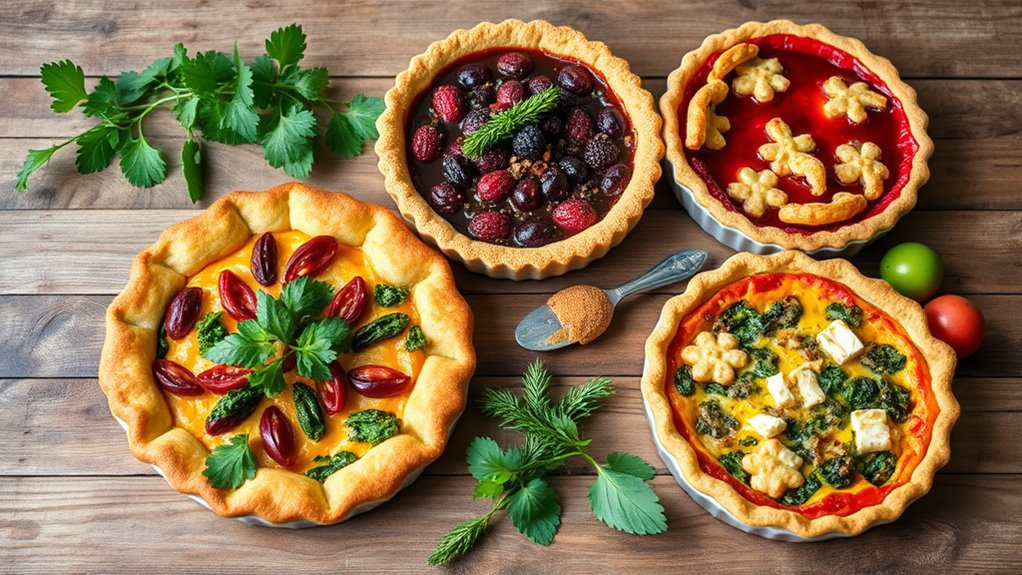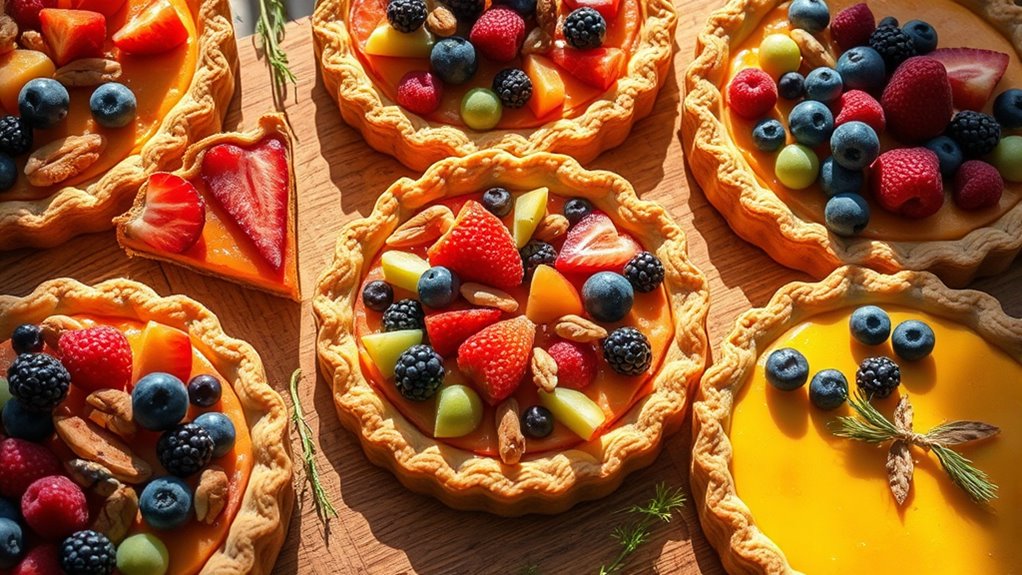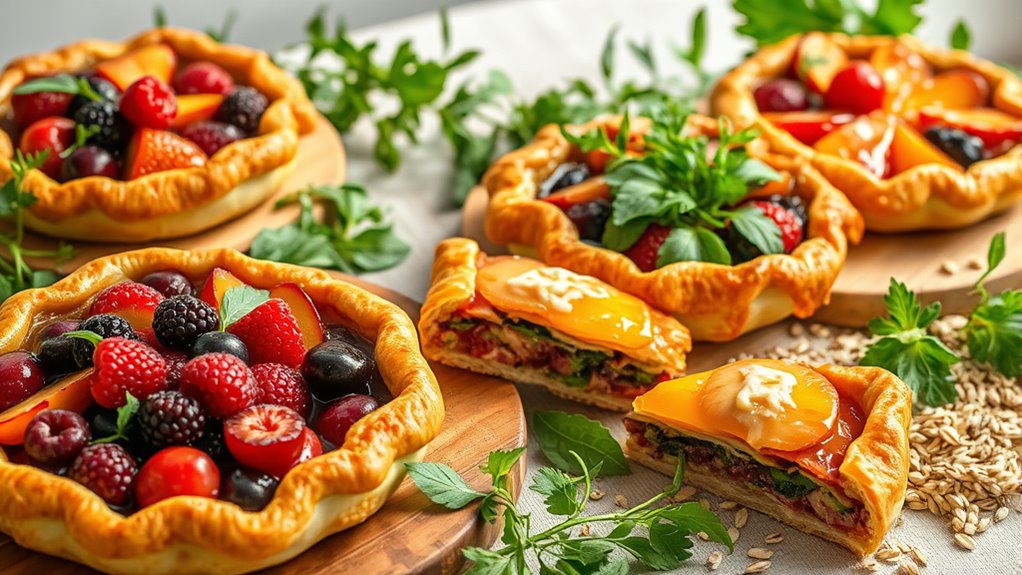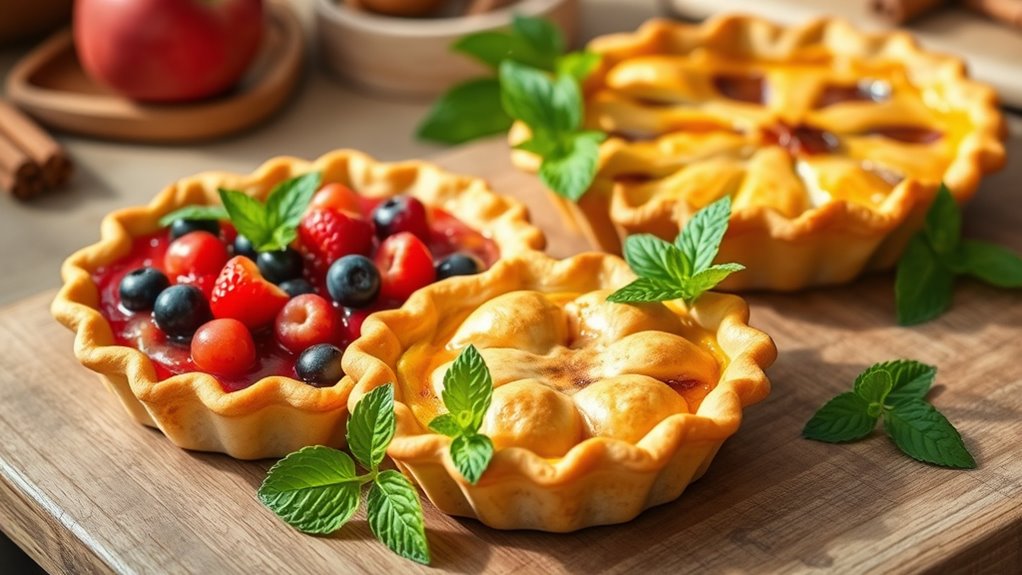You won’t believe how delicious healthy pies can be! With options like creamy pumpkin pie sweetened with maple syrup or savory veggie quiche, you’ll enjoy every bite. By swapping refined sugars for natural sweeteners and incorporating whole grains, these pies pack a flavorful punch without the guilt. You can also explore diverse fillings and crusts to satisfy your cravings. Keep going to discover scrumptious recipes and tips for making your own delightful, health-conscious pies!
Key Takeaways
- Use natural sweeteners like maple syrup or date paste to enhance sweetness without added refined sugar for flavorful pies.
- Incorporate spices such as cinnamon, nutmeg, or ginger to elevate flavors while keeping the pies healthy and delicious.
- Experiment with whole grain or nut-based crusts to add fiber and healthy fats, enhancing both taste and nutrition.
- Substitute traditional dairy with almond milk or pureed fruits for creamy fillings that maintain rich flavors without compromising health.
- Explore a variety of fillings, like Sweet Potato or Mushroom & Kale, to keep pies diverse and satisfying while being nutritious.
The Best Healthy Pumpkin Pie

If you’re looking for a wholesome dessert that satisfies your sweet tooth without the guilt, the Healthy Pumpkin Pie is your perfect choice.
This delicious healthy pie is made from pumpkin puree, sweetened with pure maple syrup, and features a creamy, dairy-free filling using almond milk. It’s not just tasty; it’s also gluten-free, making it suitable for various dietary needs.
For ideal texture, bake it for about an hour, then let it cool at room temperature before refrigerating. You can even customize the sweetness, adjusting the maple syrup to match your taste.
Plus, it stores well—refrigerate for 3-4 days or freeze for up to a month. Enjoy this delightful pumpkin pie at your next gathering!
Healthy Pie Recipes: 6 Good-for-You Savory & Sweet Pies

Healthy pies aren’t just limited to sweet options like pumpkin; there are plenty of savory varieties that bring nutritional benefits to your table. You can enjoy healthy pie recipes that use whole wheat flour for a wholesome pie crust while keeping the flavors absolutely delicious. Try these options:
| Sweet Pies | Savory Pies |
|---|---|
| Sweet Potato Pie | Mushroom & Kale Pot Pie |
| Healthier Pumpkin Pie | Veggie Quiche |
| Berry Pie (Less Sugar) | Spinach & Feta Pie |
| Chocolate Avocado Pie | Lentil & Vegetable Pie |
These pies incorporate less sugar, more fiber, and can be customized to suit your taste. Additionally, they offer essential nutrients that can help maintain overall health. With these recipes, you’ll satisfy cravings without sacrificing health! Additionally, using ingredients like baked kale can enhance the nutritional value of your savory pies by providing essential vitamins and minerals.
The History of Pie

Pie has a rich history that stretches back thousands of years, with its earliest forms emerging in ancient Egypt and Greece. Back then, crusts were merely vessels for various fillings and weren’t meant for eating.
The word “pie” even comes from the magpie bird, which gathers a mix of items in its nest, much like the diverse ingredients found in early recipes. In medieval Europe, pies combined meats and fruits, creating a delightful blend of flavors and textures.
The term “coffin” referred to the box-like crust encasing these fillings. While traditional pies often packed in sugar, fat, and meat, today’s healthier adaptations let you enjoy pie without sacrificing flavor, making it a nutritious dessert option.
How to Make Pies Plant-Based and Healthier

While traditional pies often rely on refined ingredients, you can easily make them healthier and plant-based without sacrificing flavor.
Start by replacing refined sugar with natural sweeteners like date paste or maple syrup, which provide extra nutrients. Choose whole grain or alternative flours, such as almond or chickpea flour, for your pie crusts to boost fiber and protein. Raw foods may have higher enzyme content that can aid in digestion, making them a great addition to your crust. Incorporating chia seeds can also enhance the fiber content and promote fullness. Additionally, using herbal teas like chamomile or ginger can be a soothing beverage to enjoy alongside your pie. Maintaining a balanced diet is crucial for overall health, including hair health, which can be affected by nutrient deficiencies.
Instead of eggs, use flax meal mixed with water or aquafaba to guarantee moisture and binding in your fillings. Incorporate pureed fruits or vegetables like pumpkin or sweet potatoes for added creaminess and essential vitamins, minimizing the need for unhealthy fats.
Finally, experiment with nut-based or seed-based crusts to introduce healthy fats and protein, creating a satisfying alternative to traditional options. Additionally, consider adding a splash of freshly squeezed juice to enhance the flavor profile and provide a natural sweetness to your pie fillings.
6 Scrumptious & Healthy Pie Recipes

Creating delicious and nutritious pies is easier than you might think. Start by using whole food ingredients like pumpkin puree, pure maple syrup, and almond milk for a creamy texture without dairy or refined sugars. Additionally, incorporating nutrient-dense options can further enhance the health benefits of your pies. A raw food diet emphasizes whole, unprocessed foods, making it a great inspiration for healthier pie recipes. Juice made from fresh fruits can also be used to add moisture and flavor to your pie fillings. For example, beet juice can enhance the natural sweetness while providing additional health benefits.
For wholesome crusts, swap traditional options with whole wheat flour or sugar-free alternatives to cut calories while boosting nutrition.
When it comes to pie filling, fruity choices like apples and berries naturally sweeten your pie, allowing you to reduce added sugars by up to one-third without losing flavor. Experimenting with alternative sweeteners like honey or agave syrup can elevate taste, too.
Finally, consider making miniature or individual portion pies to help with portion control, letting you savor these healthy pies without overindulging. Additionally, incorporating low carb high protein ingredients can enhance the nutritional value of your pies while keeping them delicious.
Tips and Techniques for Making Delicious Healthy Pies

When making healthy pies, swapping out traditional ingredients can make a big difference. You can enhance your crust with whole food flours and adjust baking times for the perfect texture. Let’s explore some simple techniques to help you create delicious, guilt-free pies! Additionally, using organic farms for sourcing your ingredients can contribute to a healthier and more sustainable pie-making process.
Ingredient Substitutions for Health
Making healthy pies doesn’t mean sacrificing flavor or texture; it’s all about smart ingredient substitutions. Start by replacing refined sugar with natural sweeteners like honey or pure maple syrup.
For your crust, opt for whole grain or nut-based flours to boost fiber and nutrition. You can also use unsweetened applesauce or mashed bananas instead of olive oil to lower fat while keeping your dough moist. Incorporating chia seeds into your crust can add a nutritional boost and healthy omega-3s, as chia seeds are rich in dietary fiber that aids digestion. Additionally, choosing eco-friendly materials for your baking tools can enhance your overall cooking experience. Chia seeds can also be used as a chia egg substitute to replace eggs in vegan pie crusts.
When it comes to fillings, incorporate Greek yogurt or silken tofu for creaminess without the heavy calories. Don’t forget to enhance flavors with spices like cinnamon, nutmeg, or ginger instead of adding extra sugar.
A splash of vanilla extract can elevate your pie’s aroma, making it truly satisfying and delicious! Additionally, using unsalted butter in your crust can provide rich flavor while allowing you to control the sodium content.
Crust Preparation Techniques
To achieve a delicious and healthy pie crust, focus on selecting the right ingredients and techniques. Here are some tips to enhance your crust preparation techniques:
- Use whole grain flours, like whole wheat or almond flour, for added fiber.
- Swap out butter for healthy fats, such as coconut oil or olive oil.
- Incorporate ground nuts or oats for added texture and nutritional value.
- If you need a gluten-free option, use almond flour or a gluten-free flour blend with binding agents like flax meal.
- Reduce sugar by using natural sweeteners like applesauce or mashed bananas to keep moisture while cutting calories.
- Consider using whole foods to enhance the nutritional profile of your pie filling, ensuring a balanced dessert. Additionally, embracing minimalist environments can inspire creativity in your cooking, leading to unique flavor combinations.
Baking Time Adjustments
As you immerse yourself in baking healthy pies, understanding baking time adjustments is essential for achieving the perfect texture and flavor.
Monitor the baking time closely; for healthy pumpkin pie, aim for about 50 minutes for a softer texture or 60 minutes for ideal firmness. If you’re using a store-bought crust, pre-bake it for a few minutes to enhance its texture and prevent sogginess.
Adjust temperatures slightly—lower temperatures can enhance flavors and textures without burning the crust. To check for doneness, use a toothpick; the center should be set but may still jiggle slightly, indicating a creamy filling.
These tweaks will help you create delicious, healthy pies that impress every time!
Frequently Asked Questions
What Is the Healthiest Pie to Eat?
When you’re looking for the healthiest pie to eat, consider one that features a filling made from fruits like apples or berries. They’re low in calories and packed with nutrients.
Opt for a crust made with whole ingredients, like almond flour, and use natural sweeteners instead of refined sugars. This way, you’ll enjoy a delicious pie that’s not only satisfying but also nourishing, helping you stay on track with your health goals.
What Is Healthier, Apple Pie or Pumpkin Pie?
When it comes to pie, pumpkin’s often the underdog that packs a punch!
You’ll find that pumpkin pie is generally healthier than apple pie. With lower sugar content and higher fiber, it keeps you feeling fuller longer.
Plus, you can swap refined sugars for natural sweeteners like maple syrup.
While both have their merits, pumpkin pie usually edges ahead in nutrition, making it a smart choice when you’re craving something sweet.
Is Pecan Pie Healthier Than Pumpkin Pie?
When you compare pecan pie and pumpkin pie, you’ll find that pumpkin pie generally wins in the health department.
Pecan pie packs in more calories and sugar, while pumpkin pie is lower in calories and often made with healthier ingredients like pumpkin puree.
If you’re watching your dietary intake, pumpkin pie is a better choice, especially considering its nutrient-rich profile and suitability for those with specific dietary restrictions.
Choose wisely!
What Kind of Pie Can a Diabetic Eat?
If you’re diabetic, you can enjoy pies made with alternative sweeteners like stevia or erythritol.
Opt for crusts made with whole grain or nut flours for a healthier choice.
Fruit pies with low-sugar options, like berries, provide antioxidants and nutrients.
Pumpkin pie made from pure pumpkin puree and lightly sweetened can be a delicious option too.
Remember to practice portion control; mini pies can help keep your carbohydrate intake in check.
Conclusion
In your quest for flavorful, fit-friendly pies, remember that healthy doesn’t have to mean bland. By embracing bold ingredients and clever cooking techniques, you can create delicious desserts that delight the senses. So, whether you’re whipping up a warm pumpkin pie or a savory spinach creation, keep experimenting and savoring every bite. Pies can be both pleasing and nutritious, proving that taste and health can harmoniously coexist. Immerse yourself in your pie-making adventure today!









